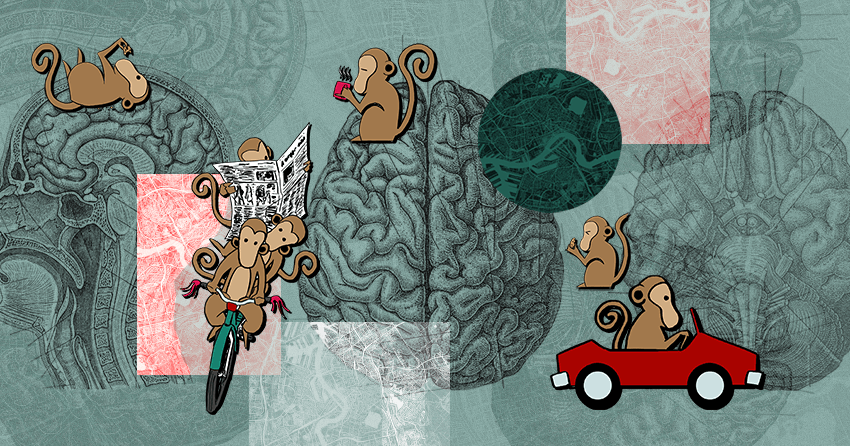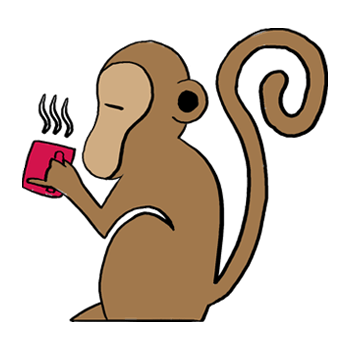Mensa Brain or Monkey Brain — Which Is at the Helm of Our Voluntary Activities?
Surprisingly, primitive directives of the subconscious mind dictate many of our decisions

Why is it that we humans can be so … odd? I began studying human behavior more than 10 years ago, specifically, the workings of the subconscious mind. To be clear, I’m not a psychologist or neurologist. I’m just a regular guy who experienced an unnerving event that made me feel I needed a better understanding of how our minds work. (More on that humbling event later.)
After reviewing countless books, journals, and scientific studies, it turns out that the rational, insightful, highly evolved conscious mind we humans (especially Mensans) are so proud of is controlled mostly by primitive dictates of the subconscious mind. Almost all of our actions are being controlled by a primal monkey brain.

In his book Incognito: The Secret Lives of the Brain, renowned neuroscientist Dr. David Eagleman lays out the foundation of our monkey brains: “The conscious you — the I that flickers to life when you wake up in the morning — is the smallest bit of what’s transpiring in your brain […] the brain runs its own show. Most of its operations are above the security clearance of the conscious mind.”
Your conscious self, what Dr. Eagleman calls the “I” and what I have come to think of as the Intellect, relates to how you consciously think, feel, and make choices. That’s the part of your brain you assume you have control over, except you do not necessarily make even its decisions. Not the Intellect you, at least. Turns out, our conscious mind is mostly just a yes man rationalizing decisions being made subconsciously.
Primal directives, relics of our evolutionary past, act like the rules of an algorithm through which all information is processed while you’re unaware any processing is even happening. What comes out the other side controls almost all your actions and decisions, and those algorithms are being run by your completely autonomous Monkey Brain. Not you. Not Intellect. Monkey Brain.
Monkey Brain is the construct I use to describe the subconscious programming that runs our lives. (It’s also the title of my book, due out this November through Villa Magna Publishing). Think of it as the amalgamation of our brain’s many autonomous programs that control all sorts of functions we’re not aware of at any given moment. Of course, we understand that our breathing, sense of balance, heartbeat, and more are all activities we don’t have to think about yet still happen. Those are part of our autonomic nervous system, as coined by British scientist John Langley around the turn of the 19th century. More interesting, however, is that complex learned skills also become automatic over time.
* * *
In a 1974 Cognitive Psychology article, “Toward a Theory of Automatic Information Processing in Reading” (LaBerge and Samuels), the term automaticity was first introduced pertaining to reading skills. We start to read by sounding out individual letters to form words, but later we can simply look at words and know what they are and what they mean without even thinking about the letters.
This automaticity doesn’t apply to just reading. It’s always in effect and can figure into almost anything we do. It’s why you can get in the car and drive to work thinking about the fight you had with your spouse last night and still arrive without incident. You didn’t think about which turns to take, how to steer, or even about braking when you saw red lights. You just did it on autopilot. We all have hundreds of these automatic programs running in the hidden recesses of our brains. Whether innate, learned, hard-wired, or soft-wired, take them all together and you get Monkey Brain.
The particular event that started me studying the subconscious mind was the first time I recall being aware that someone other than me was controlling my actions. I was a neophyte commodities trader on my first solo trade when things went horribly off track. In the aftermath, as I assessed what went wrong and looked back at my actions, I was dumbfounded.

In the heat of a market meltdown, my mind was arguing with itself, telling me what to do, and then immediately providing a counterargument for why I shouldn’t do it. The actions I took were exactly the opposite of what I had earlier decided to do, even though I had prepared for what to do if things went wrong. When the trade moved against me, I didn’t just lose a ton of money, I started acting like a different person! How could my supposedly high-functioning Mensa brain completely fail me and seemingly make me do things I had already decided not to do?
Of course, it wasn’t my Mensa brain at all that was the culprit. The Monkey made me do it!
The primal directives Monkey Brain follows are very basic (in fact, primitive) and unalterable because they are the product of millions of years of evolution. If you think your Intellect, the product of a paltry couple hundred thousand years of evolution, can step in and countermand the Monkey, you are sorely mistaken. Monkey Brain has been winning the battle for millennia, and a big reason is that we are largely unaware that Monkey Brain is working at all, much less calling the shots. This can lead to some difficult life events and odd behavior, including very expensive commodity trades.
The primal directives governing all Monkey Brain decisions are Survival, Comfort, Acceptance, Power, Greed, and Identity. Most of your decisions are actually a battle between which primal directive is going to take precedence. For instance, a fight response might be tied to Power, Greed, or Acceptance directives, whereas a flight response could be tied to Survival and Comfort.
Your Monkey Brain calculates all your saved inputs in microseconds and determines what you’re going to do before your Intellect even knows what’s going on. It’s calculating … how much can I gain in status, power, and wealth if I win the fight? How much status, pain, and effort are at stake if I lose? Later, whether you fought or flew, your Intellect will step in, rationalize everything, and make it all OK. Monkey Brain will defend your actions, and it will all be logical, reasonable, and completely true to you. Monkey Brain decisions are wired into your brain, and there’s nothing you can do to change that. Or can you?
* * *
In 1948, Polish neuroscientist Jerzy Konorski posited neuroplasticity, the notion that our brain could essentially rearrange itself to better process information. Konorski was expanding upon the famous work of Ivan Pavlov and his dogs by pairing animals and training only one of a pair extensively for several years then studying their respective brains. He found that the training had physically changed the structure of the animals’ brains, creating new neural pathways.
Today, we know that the neural network inside our brain changes itself every day, all day, with every thought and action we take. Understanding that we affect our brain’s wiring with thoughts and actions means we can learn to rewire ourselves to react in ways that help us achieve our goals rather than undermine them. We can’t turn Monkey Brain off, but we can teach it to interpret and react differently. By consciously rejecting thoughts that we know take us down an undesirable path and purposefully redirecting ourselves to thoughts and actions that lead us to better outcomes, we can essentially self-evolve. Neuroplasticity allows us to pave new roads in our brain that take us to better places than we used to go. And if we focus on doing that long enough, we can automatically end up in those better places, just like absent-mindedly driving a car.
As an example, let’s say you have decided to cut down on sugar in your diet. You’ve contemplated the benefits as well as the difficulties and made a decision. You will eat nothing that contains added sugar. It’s a simple plan, and you’re going to do it. You want to do it, and it’s good for you. Then, right after you decide to do it, somehow you just … don’t … do it. How odd. Intellectually the plan makes sense and even seems to align with Monkey Brain’s primal directives of Survival and Comfort. Unfortunately, there are powerful aspects of Monkey Brain working against you.
First, those carefully crafted arguments about how it’s going to be good for you are falling on deaf ears. Monkey Brain can’t hear or acknowledge reasoned arguments. Monkey Brain is all instinct. Those millions of years of evolution hard-wired your Monkey Brain to seek calories (especially sugar) and conserve energy. Calories and inactivity are in immediate alignment with Survival and Comfort, while the benefits of ditching sugar are in the future. Primal directives don’t exist in the future but in the right now. Monkey Brain will sabotage you every time you think about doing something for a future benefit. You might tell yourself, “I will cut down on the sugar in my diet,” but Monkey Brain’s not having it. Soon, you’ll hear, “I’ve been so good today. I can have one little cookie,” right before you realize you ate three.
To make change stick, you have to focus on and reinforce the directive that leads you down the neural pathway you want to be on.
Of course, we all know people who have cut out sugar from their lives or, in some other way, dieted with success. But how can they if we all respond to the same primal directives? It’s because we respond more or less strongly to each directive based on who we are as individuals. This question of why we’re different even though we share much of the same brain biology and instinctual preconditioning dovetails into the age-old nature versus nurture debate. Are our brains different because we were born that way or because we had different experiences throughout our lifetimes, creating different neural networks?
* * *
Biostatistician Dr. Beben Benyamin and his team from the Queensland Brain Institute found a specific answer to that question in 2015. They conducted an exhaustive meta-analysis of every study of twins conducted in the past 50 years, reviewing data on more than 14.5 million pairs of twins, effectively distilling the simple answer: It’s both nature and nurture — or, more specifically, 49 percent attributable to nature and 51 percent to nurture. In a conclusion that was impactful but perhaps obvious, Benyamin noted, “There is overwhelming evidence that both genetic and environmental factors can influence traits.” Our differing and constantly changing neural networks mean that although we are all influenced by every directive, each of us will have different directives that push us harder.
Critical to understanding how to intentionally change behavior and make it stick is realizing that the directives are almost always competing for dominance. You want the Acceptance you can get by working out and having a killer body, but you also crave Comfort. Which one wins? That is constantly in flux, which is why you might start a workout plan with Acceptance as the driver but don’t stick to it when your need for Comfort takes over. To make change stick, you have to focus on and reinforce the directive that leads you down the neural pathway you want to be on.

The formula for change that sticks requires you to recognize, examine, and divert. When you start paying attention, you will recognize the Monkey at work. You will notice when a voice in your head pipes up and says, “You can have one little cookie.” Once you recognize this thinking and stop and examine it logically, you’ll think, Isn’t that funny? I’m talking to myself, trying to convince me to eat a cookie! The last step, to divert, becomes much easier with your Intellect reinserted into the equation. Repeating the recognize-examine-divert exercise diminishes the neural pathway that leads to sugar and reinforces the road to health and the self-image of someone in control. And once you get started on that healthier path, if you stick to it long enough, your brain’s plasticity will start to make it automatic. You can use your Intellect to focus Monkey Brain on different directives and override any bad programming your brain has been following. Regardless of whether it was nature or nurture, neuroplasticity can change it.
You can change it.
* * *
Perhaps you’re now contemplating some of those neural programs on autopilot in your own brain that you might want to reroute. Identifying the behavior you want to change is step one in self-evolution. Then you must challenge the Monkey!
The next time you find yourself struggling to achieve the goals you’ve laid out or are wondering why you acted in a way that’s just not You, take a pause and consider: Is it possible that Intellect has failed and Monkey Brain has taken over? Have you, odd as it sounds, been getting in your own way? If so, you might have been executing the plan that Monkey Brain made long before Intellect ever got involved. Interrupt any skeptical head-talk and ask yourself, “Based on my actions, is it my Mensa Brain that’s in control right now, or is it my Monkey Brain?”
The shocking little secret that you may not want to acknowledge is … it’s not the first one!

